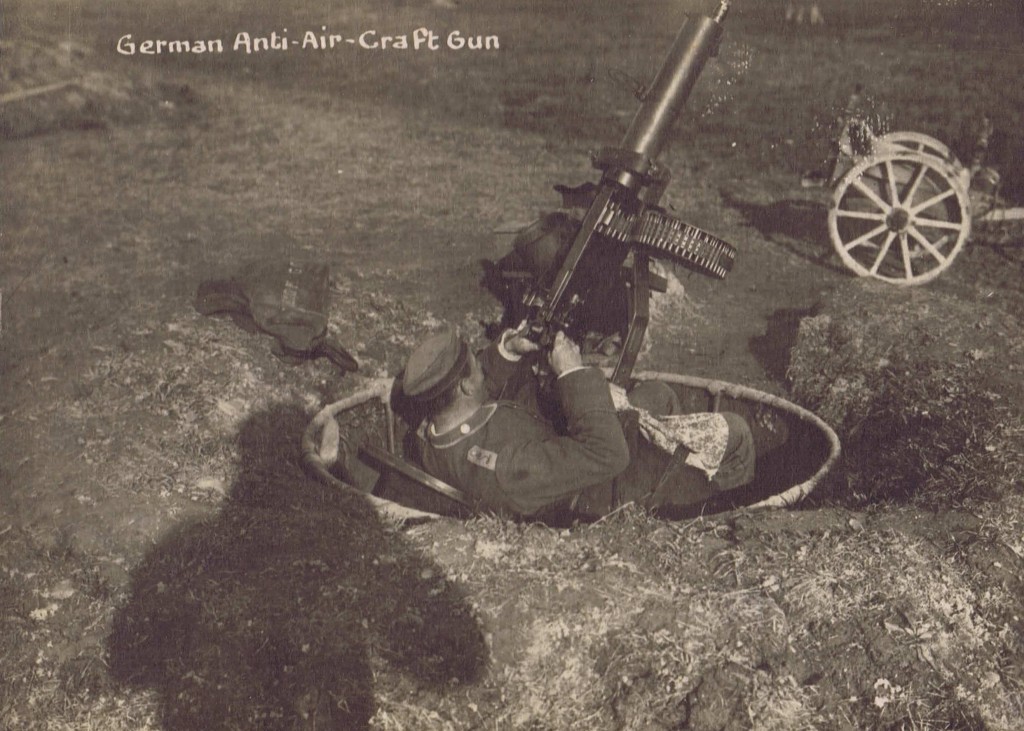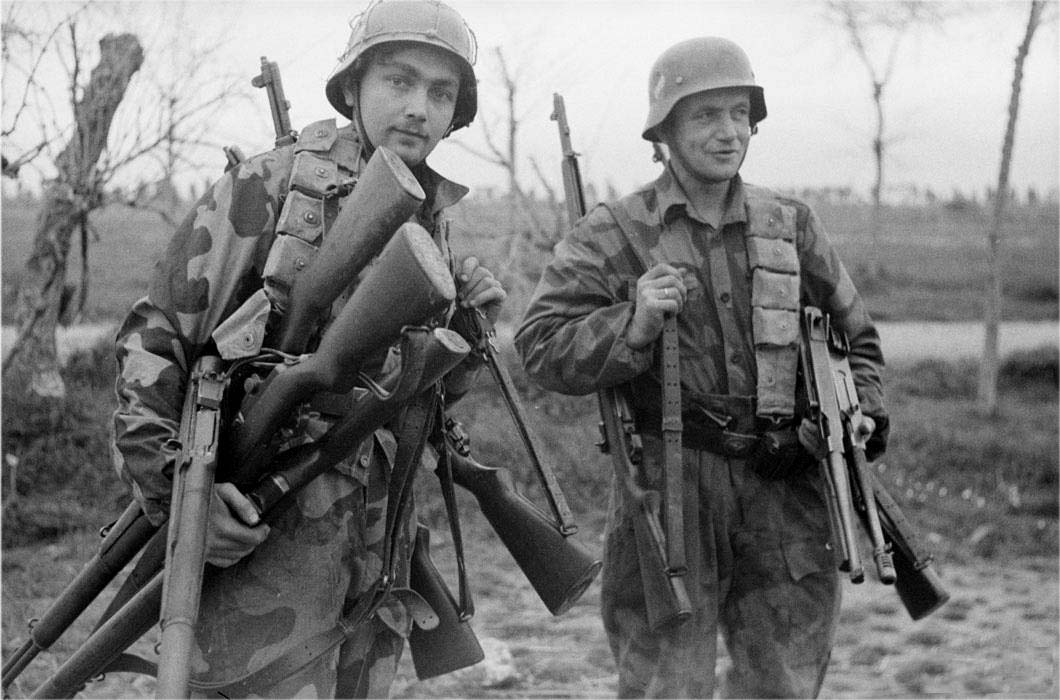
German MG08 Maxim in antiaircraft mounting, at some point during WWI. Note the spider sights mounted halfway down the jacket, and the belt reel. Those reels allowed the guns to reliably feed at all manner of odd angles – much better than having a long belt hanging down to an ammo can.



I suppose ambushing this gunner would be difficult. If this mount is what I think it is, the gunner can change the elevation of his chair to counter any would-be commandoes. Remember that there are a few other gunners near him and several spotters and ammo carriers. Unless you had a tank or long-range artillery, this guy would chew your forces to pieces.
Coincidentally, while the 8.8 cm Flak 18 and its variants were not as powerful as their Allied or even Italian peers (the Cannone da 90/53 was slighty better in the anti-air role and even nastier to Allied tanks in the desert than the Flak), the Flak 18 gets credit for having the a versatile gun mount to allow for firing at ground targets. Allied heavy AA guns initially didn’t have strong enough mounts or ground-type sights to counter enemy infantry or tanks.
Weapon of choice questionnaire:
Given a choice, which would you have if in some outlandish scenario your hometown were under attack by parachuting sky pirates (likely from the zeppelins mentioned in the Mars #4 pistol commentary) and tank-riding bandits at the same time?
1. MG 08 with K bullets in the configuration depicted in today’s photo
2. Double Lewis Gun AA mount
3. Oerlikon 20mm AA
4. Hotchkiss 25mm AA
5. PTRD-41 anti-tank rifle
6. M15 Combined Gun Motor Carriage
7. Junkers Ju-87 D-5 with gun-pod-mounted 20mm cannons to supplement its own wing mounted cannons
8. 8.8 cm Flak 18 (Sf) auf Fgst Zgkw 12t Sd.Kfz.8 “Bunkerknacker”
9. truck-mounted Cannone da 90/53
10. Krupp K5 railway gun
11. Screw the budget and add your favorite toys to this list!
This questionnaire is a voluntary item. You are not required to participate if you do not wish to do so. Please keep any and all criticism of this post humane and free of foul language.
Thank you,
Cherndog
“MG 08 with K bullets in the configuration depicted in today’s photo”
Too low range for engaging Zeppelin, during the WW1 German Zeppelins bombing London were flying at too high altitude for current British aeroplanes to intercept.
“Screw the budget and add your favorite toys to this list!”
5″/38 Dual purpose US Navy Mark 12 gun
http://www.navweaps.com/Weapons/WNUS_5-38_mk12.htm
If i could 4 would have a crusader AA variant either with the dual or triple 20mm oerlikon guns if all i am dealing with is paratroopers or if they happen to bring some more zeppelins and even armoured vehicles the 40mm bofors variant.
“Well, it’s over folks. It’s all over! All over EVERYTHING!!” I wonder what loot you will expect to get from this turkey shoot.
Is there a Yeti lurking in the shadow… Bunkerknacker, for me.
YETI!?!?!? [loads the 8.8 cm flak gun with HE shell]
Actung! He looks like he’s smiling anyway, the soldier.
A ZSU-23-4 Shilka is pretty versatile, especially if you add some infantry with machine guns and AT missiles.
ZSU-23-4 may have too small maximal altitude to engage Zeppelin, it was designed to engage helicopters and low flying attack aeroplanes.
Actually ZSU-23-4 is being phased out in service in favor of Tunguska (2K22, Grison in NATO parlance) armed with 2 x twin 30mm auto-cannon aswell ground-to-air rockets.
Concurrent AA defense set used with ZSU-23-4 for medium level AA fire: Kub (2K12, Gainful in NATO parlance). Interestingly 3M9 missile doesn’t use plain rocket-engine, but ramjet propulsion.
The early US Navy “Talos” missile similarly was built around a ramjet. Presumably this is more fuel-efficient than a pure rocket design, giving better range.
germans learned about using the flak 8,8 during the spanish civil war, and modified it accordingly. in france 1940 they realized it’s potential against heavy tanks.
flak guns and batteries were under luftwaffe command, so the army wing had to request them.
In North Africa, those requests were frequent, as the 8.8cm Flak (18 or 36) was about the only thing that could take out a Matilda II before it got into the infantry areas. It was slow, but largely invulnerable to anything else the Afrika Korps had, until the PzKw IV/F2 with the long 7.5cm showed up. By which time it had been largely superseded by Grant and Sherman, anyway.
The Luftwaffe was required to comply (by Rommel’s HQ) but they hated it. As Ian Hogg related in The Guns 1939-45, such a “loan” was basically a one-way street, as the AT gunners would strip off the complex AA sight system, bolt improvised shields on, and generally render the gun useless for future AA use.
The later model Flak 36/41 (IIRC on designation) was a “purpose-built” dual-role gun that came with shields and AT sights already attached. I suspect this was to encourage the AT crews to not go at the guns with wrenches, hacksaws, and an evil glint in their eyes.
cheers
eon
Several units of Flak guns were not purely AA or AT but mixed, where some of the four-gun batteries were manned by the proper AA crews and the others would be manned by the AT crews. In any case, from a distance, you couldn’t tell which was which. And as for the Luftwaffe hating the forced conversion, I don’t blame the AA crews for disliking most of the mods, but they probably were grateful for the shields in one manner-nobody wants airplane-thrown-bomb debris in the kidneys.
“in one manner-nobody wants airplane-thrown-bomb debris in the kidneys”
Still shield on AA guns is protection only from one direction, so far I know it was mainly for protection against ground enemy – notice that stationary pure AA gun (as used to defend cities, industry etc.) often lacks shield. As a interesting fact: Flakturms
https://en.wikipedia.org/wiki/Flak_tower
in Berlin were last points of resistance during Fall of III Reich as it were immune to heavy bomb and artillery, it even engaged ground forces with its Flak guns.
Getting back to the Photo of the MG08 in AA Mode…Note the piece of printed cloth (Table cloth, Kitchen apron, Curtain?) used by the gunner across his thighs and knees to deflect spent (hot) cartridge cases as they eject out the Tube in the trunnion block. To make sure it moves with the Gun, he has it tied to the two support stanchions of the mount.
As to the Spool, The French used a 500 round spool for the Hotchkiss Portatives adapted for Aircraft use with a steel flexible plate belt ( for 8mm Lebel, it was one clasp (plate) per cartridge, well before the Germans got into spool use.French 1914-15,after which Guns on French aircraft were usually Lewis (.303) and Darne(“7,7” (ie, .303.). Germany used spools (100 rds) in the 08/15 ( 1916 onwards) so the Idea of the Large spool for what is essentially a “fixed Position” MG08 is about that date as well.
The photo itself looks like a “Posed” Training shot, from the two wheeled Cart in front ( for the gun or the ammo?); the soldier’s haversack? or Spent Cartridge Bag? lying on the ground, and the fact that the soldier is wearing a Feld-Mutze ( Forage cap) and not a standard M16 Helmet, if he was in a front or second line position.
Nice Photo…shows some of the lesser researched area of WW I History.
Doc AV
Good catch on the “apron”. I guess that was a major enough nuisance that they’d want to address it even in training.
I’m not sure a specialized AA mount like that would ever have been deployed in the front line. Trench strafing might have been a threat at the very end of the war, but C3 (including balloons) and logistical targets, and perhaps artillery batteries, would probably have been first priority for such protection.
Aces high, that’s a good film for showing the vulnerability to small arms fire from the air or ground being in “paper” planes with no parachutes. That Lewis was handy on the top, drill the hun when passing.
Ach ! Deutsches Audubon Vehrin ! Komm Pigeon Komm !